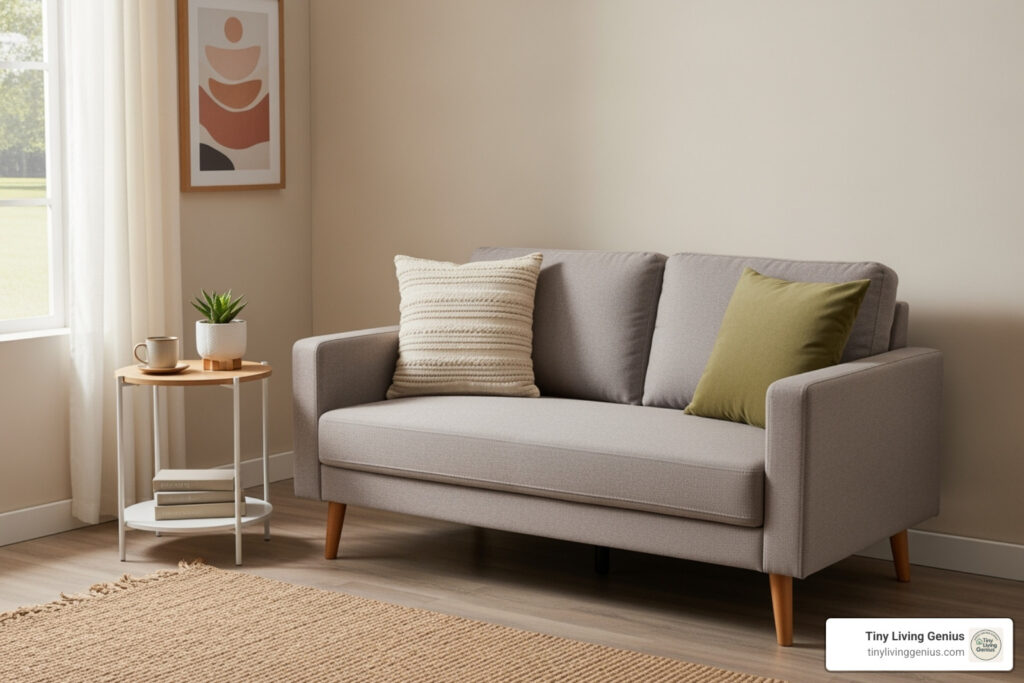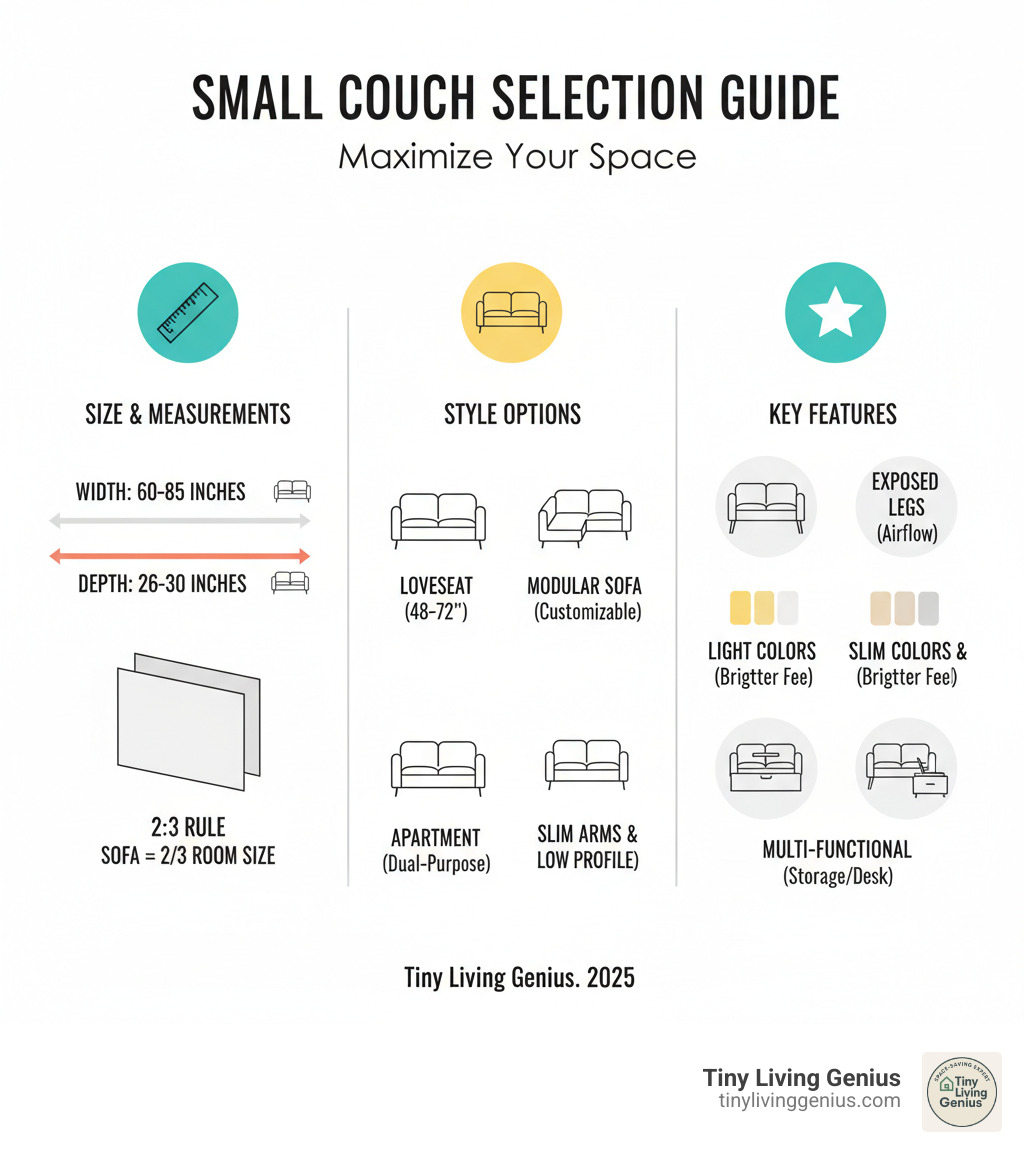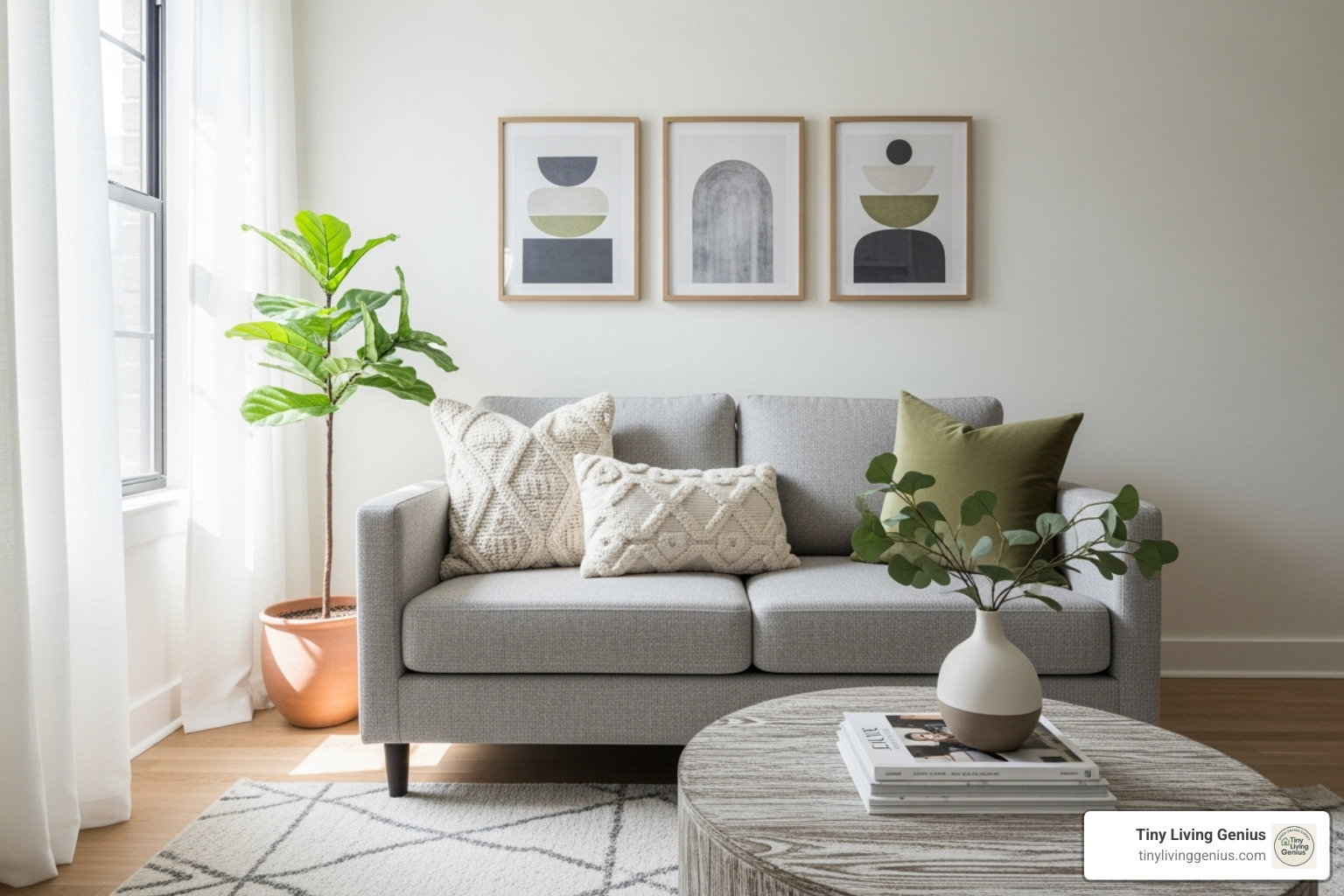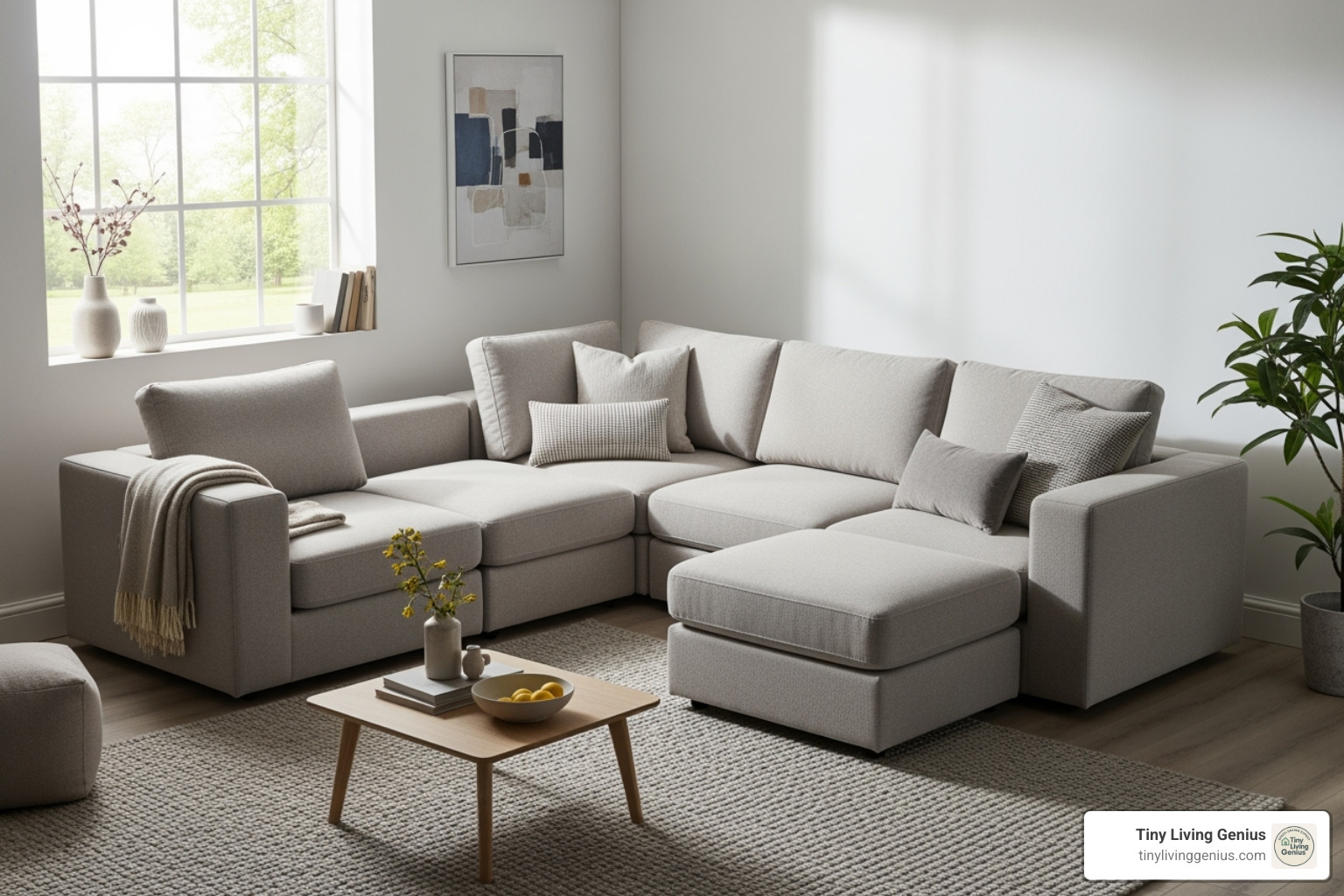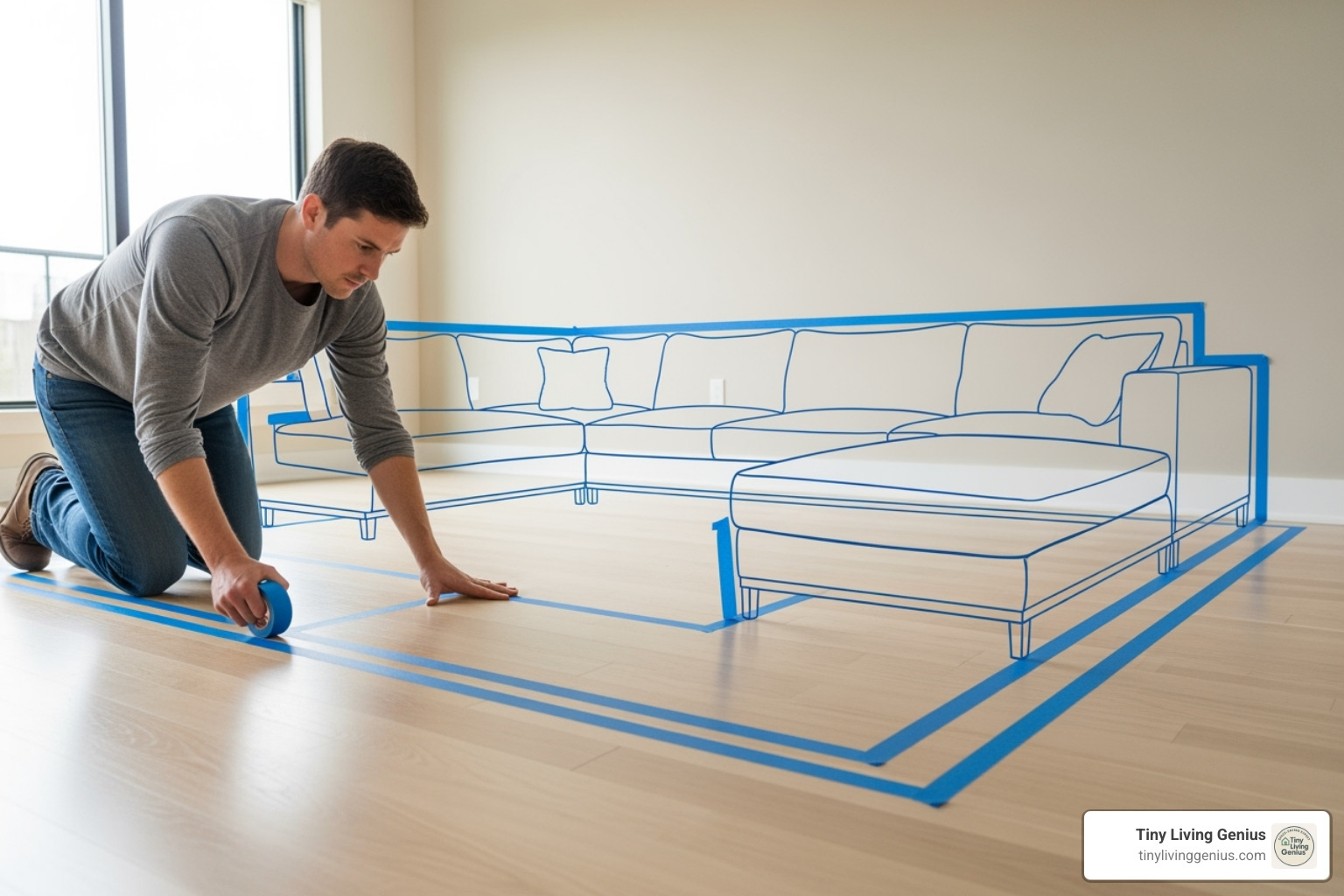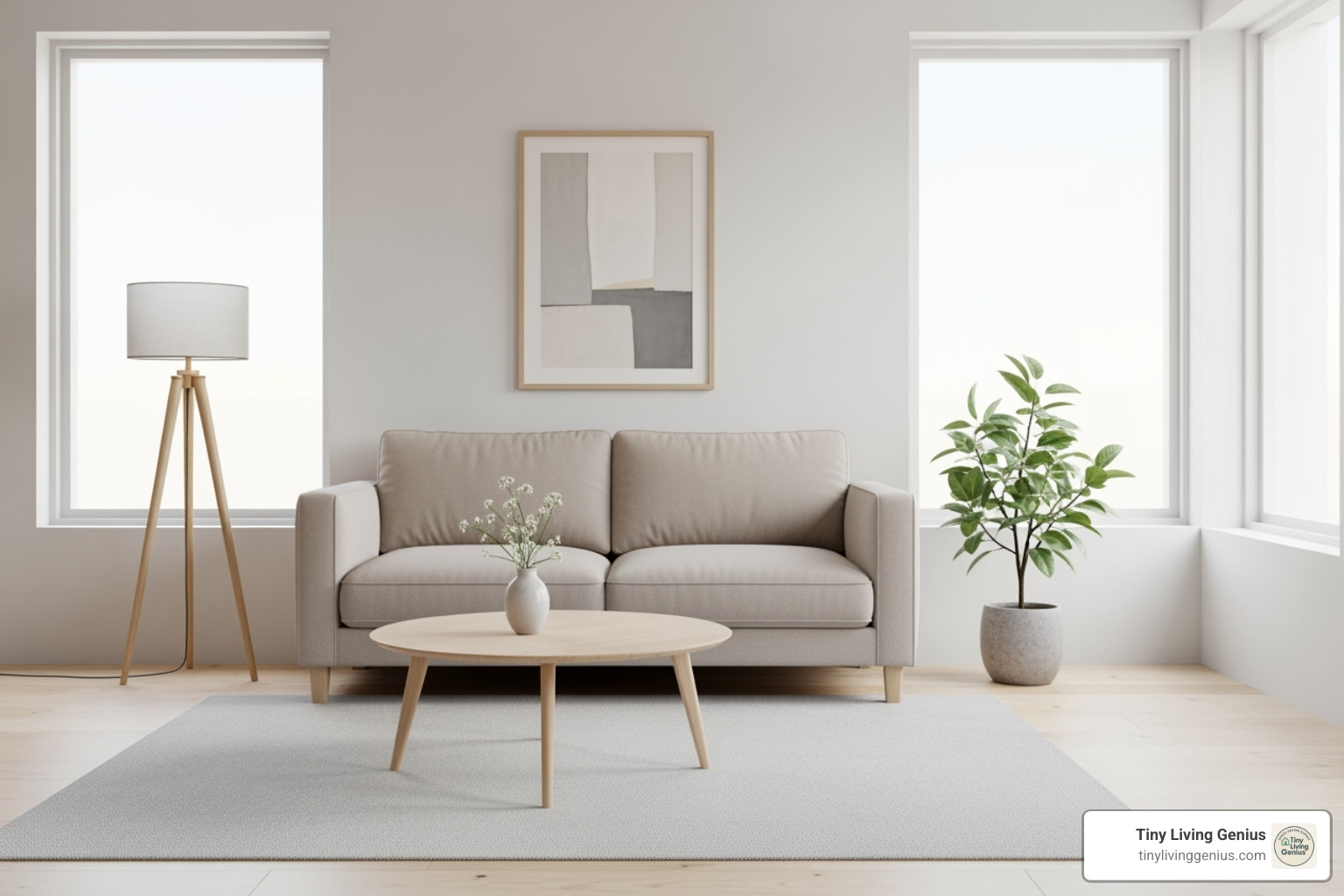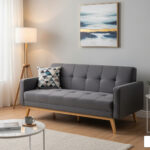Small Couches for Small Spaces: Top 2025 Guide
Why Small Couches for Small Spaces Are Your Secret Weapon
Small couches for small spaces are the perfect solution for creating comfortable, stylish seating without overwhelming your room. Here’s what you need to know:
Best Types for Small Spaces:
- Loveseats – 48-72 inches wide, perfect for two people
- Apartment-sized sectionals – Around 67-77 inches with chaise options
- Modular sofas – Customizable pieces you can reconfigure
- Sofa beds – Dual-purpose seating and sleeping
Key Features to Look For:
- Exposed legs to create visual flow
- Light colors (cream, beige, light gray) to reflect light
- Slim arms and low profiles
- Multi-functional designs with storage
Ideal Dimensions:
- Width: 60-85 inches maximum
- Depth: 26-30 inches for comfort
- Follow the 2:3 rule – your sofa should be 2/3 the size of your room
Living in a small space doesn’t mean sacrificing comfort or style. As one furniture expert notes, “some of the coziest, most inviting living rooms are in condos, apartments, and compact homes.” The key is choosing the right piece that maximizes both function and visual appeal.
The global furniture market is booming, with compact and multi-functional pieces driving much of the $100.5 billion industry growth. This reflects what many urban dwellers already know – smart furniture choices can transform even the tiniest spaces into comfortable, functional homes.
I’m Ramy Saber, a Civil Engineer and founder of Tiny Living Genius, where I help people maximize comfort in compact living spaces. Through years of research and hands-on experience with small couches for small spaces, I’ve learned exactly what works (and what doesn’t) when furnishing tight quarters.
Why a Small Couch is a Big Win for Your Space
Think choosing a smaller couch means settling for less? Think again! When you’re working with limited square footage, small couches for small spaces aren’t just a compromise – they’re actually a smart strategic choice that can transform your entire living experience.
Let’s start with the obvious benefit: space optimization. A well-chosen small couch gives you all the comfort you need for relaxing and entertaining without hogging every inch of floor space. This leaves room for the things that make a house feel like home – maybe a reading nook, a coffee table you can actually walk around, or simply some breathing room that makes your space feel less cluttered.
This extra space creates something magical: improved traffic flow. You know that awkward sideways shuffle you do around an oversized sofa? With a properly sized couch, those days are over. Your guests can move naturally through your space, and you’ll never again stub your toe on a furniture corner in the dark.
Here’s where things get really interesting – proportional design matters more than most people realize. Picture a tiny studio apartment with a massive sectional crammed into it. It’s like wearing a suit three sizes too big – technically it works, but it doesn’t look right. A small couch that’s scaled to your room creates visual harmony that actually makes your space feel larger and more put-together.
The versatility of modern small couches is where they really shine. Many are designed to be multitasking heroes – think sofa beds for overnight guests, built-in storage for blankets and books, or modular pieces you can rearrange when you’re ready for a change. This adaptability is perfect for anyone embracing the urban living trend where every piece of furniture needs to earn its keep.
And here’s a pleasant surprise: small couches can be incredibly cost-effective. Less material often means a friendlier price tag, so you can invest in quality construction and beautiful upholstery without maxing out your credit card. It’s proof that good things really do come in small packages.
At Tiny Living Genius, we’ve seen countless small spaces transformed by smart furniture choices. The right couch doesn’t just fit your room – it improves your entire lifestyle. For more insights on making every furniture decision count, check out our guide on Choosing Furniture for Small Spaces Effectively.
Types of Small Couches for Small Spaces
Finding the perfect small couches for small spaces used to feel like searching for a unicorn. Thankfully, furniture makers have caught on to our compact living needs, creating brilliant designs that pack style and comfort into surprisingly small footprints.
Loveseats remain the classic choice for good reason. These two-person wonders typically stretch 48 to 72 inches wide, making them perfect when you need real seating without the bulk of a full-sized sofa. Whether you’re furnishing a studio apartment or adding a cozy reading nook to your bedroom, loveseats deliver that “just right” feeling that Goldilocks would approve of.
Don’t let anyone tell you that apartment-sized sectionals are impossible in tight spaces. These clever scaled-down versions usually measure around 67-77 inches wide and often include a reversible chaise that you can flip to either side. The beauty of a small sectional lies in its completeness – you get ample seating and a spot to put your feet up without needing extra furniture cluttering your space.
Modular sofas are like furniture Legos for adults. These individual pieces let you create exactly the configuration your space demands, whether that’s an L-shape tucked into a corner or a straight line against the wall. When life changes – and it always does – you can rearrange these pieces instead of buying all new furniture. It’s the kind of flexibility that makes small-space living feel less limiting and more creative.
When overnight guests are part of your life but a guest room isn’t in your budget or floor plan, sofa beds and futons become absolute heroes. These dual-purpose pieces transform from comfortable daytime seating into a proper bed when needed. Modern designs have come a long way from those notorious “bar-in-your-back” sleeper sofas of the past. For even more space-saving sleep solutions, check out our Guide to Foldable Sofas for Small Living Rooms.
Armless sofas might seem like a small change, but removing those bulky arms creates surprising visual and physical space. You’ll fit more people on the same width of sofa, and the clean lines make your room feel more open. It’s one of those simple design tricks that delivers big impact for small spaces.
Each style brings something special to compact living. The secret is matching the right type to your specific needs, room size, and lifestyle. After all, the best small couches for small spaces are the ones that make your home feel perfectly sized for your life.
Key Features and Smart Designs to Look For
When searching for the perfect small couches for small spaces, size is just the start. Thoughtful design details can transform a compact piece into a hardworking superstar for your living room. In a small space, every feature should be functional.
What to look for in small couches for small spaces
The best small couches for small spaces are multi-functional. Multi-functionality is key because when space is tight, your furniture needs to work overtime. A sofa that converts to a bed, like the Joybird Briar Sleeper Sofa, saves you from choosing between seating and sleeping space.
Built-in storage is another game-changer. Hidden compartments under seats or in chaises can hide blankets, books, and other items that create clutter. The Linsy Home 3 Seat Couch includes storage in its ottomans and cushions. For more clever ways to keep your compact space organized, check out our guide on Smart Storage Solutions for Small Spaces.
Removable and washable covers are a huge plus for maintaining your investment. Life happens, and being able to machine wash covers keeps your couch looking fresh. The IKEA Uppland Sofa is a great example with its easily replaceable slipcovers.
The shape of your couch also matters. Slim arms maximize seating space without adding bulk, while low profiles keep sight lines open, making the room feel larger. A design trick with a big impact is exposed legs. Seeing the floor underneath your couch creates an airy feeling. Interior designer Devin Shaffer recommends this feature to prevent furniture from looking too heavy.
Choosing the Right Upholstery Material
Your upholstery choice affects your couch’s look, feel, and durability. As Gifty Walker from Joybird puts it, consider “who is using the furniture and how?” A home with kids and pets has different needs than a quiet studio.
| Material | Durability | Feel | Maintenance | Pros | Cons |
|---|---|---|---|---|---|
| Leather | Very durable, wears well over time, develops patina | Smooth, cool, can feel luxurious | Regular cleaning and conditioning required. | Long-lasting, easy to wipe clean (spills), hypoallergenic. | More expensive, can scratch, feels cold initially. |
| Velvet | Durable, resistant to snags (especially performance velvet) | Soft, plush, luxurious | Can attract dust/pet hair, some require dry cleaning. Performance velvet is often stain-resistant. | Neat, comfortable, rich appearance. | Can show wear in high-traffic areas, some are high-maintenance. |
| Linen | Durable, breathable | Crisp, cool, natural | Prone to wrinkles, can stain easily if not treated. Some are machine washable (slipcovers). | Breathable, natural look, strong fibers. | Wrinkles easily, can be expensive. |
| Performance Fabrics | Highly durable, designed for heavy use, stain-resistant | Varies (often soft, can mimic other materials) | Easy to clean, often water-resistant and stain-resistant. | Excellent for high-traffic homes, pet/kid-friendly, wide variety of styles. | Can be less breathable than natural fibers, potentially higher cost. |
Performance fabrics are ideal for busy households. These engineered materials resist stains, spills, and pet claws. If you have pet-friendly or kid-friendly needs, polyester blends or performance fabrics like those on the Albany Park Lido Sofa are a wise choice.
For allergies, hypoallergenic materials like leather or tightly woven synthetic fabrics trap fewer allergens than plush options.
Be honest about your lifestyle. A beautiful linen couch might suit a calm, adult-only space, but a performance fabric is better for juggling kids, pets, and busy schedules.
Measure Twice, Buy Once: Your Guide to the Perfect Fit
To avoid the heartbreak of a couch that doesn’t fit, never skip the measuring step. A common mistake when shopping for compact furniture is failing to measure properly, which can turn your room into an obstacle course.
As interior designer Shivani Vyas advises, “Start by measuring your room’s layout and architectural elements, including (but not limited to) beams, windows, fireplaces, and doors.” This is your insurance policy against buyer’s remorse.
Start with your room. Measure its length, width, and height, noting the location of windows, outlets, and other features. A good rule of thumb is that your sofa should be about two-thirds the length of the wall it’s against to ensure visual balance.
Next, map the footprint. Use painter’s tape to outline the couch’s dimensions (length, depth, height) on your floor. This simple trick helps you visualize how much space it will occupy and if it will create traffic jams.
With the tape outline in place, check your pathways. Can you move comfortably around the imaginary couch? You need at least 30-36 inches of clear pathway for easy movement. If it feels tight now, it will be worse with an actual sofa.
Don’t forget to measure doorways and stairwells. Measure every entry point: your building entrance, elevator, hallways, and apartment door, including tricky turns and low ceilings. Many small couches for small spaces are designed for easier delivery. Modular sofas like the Lovesac Sactional arrive in separate pieces, and many sofa beds break down for transport.
A few minutes with a tape measure can save you hours of frustration and costly return fees. For more guidance, see our How to Choose the Right Furniture for Your Small Space: A Comprehensive Guide.
Styling Your Small Couch to Improve Your Space
Your small couch for small spaces is more than just a place to sit—it’s the heart of your room’s design. When styled thoughtfully, this compact centerpiece can make your space feel larger, more welcoming, and uniquely yours. Since the couch is a major piece, its style sets the tone for everything else.
Popular styles for small couches for small spaces
Certain design styles are particularly well-suited for compact living.
Mid-century modern remains a favorite for its clean lines, tapered legs, and lack of bulky details. The streamlined silhouette of pieces like the Burrow Nomad Sofa creates visual breathing room without sacrificing comfort.
Minimalist design takes a “less is more” approach. These couches feature clean lines and neutral colors, creating a calming anchor in your room while keeping the space feeling open and serene.
Scandinavian style blends cozy comfort with airy design. Think light wood legs, soft textures, and an effortless hygge feeling. These couches often use natural materials and understated upholstery that never feels overwhelming.
The color of your couch can change how big your room feels. As interior designer Kathy Kuo suggests, neutral hues like sand, beige, and cream “blend well into a room and make it feel bigger by not bringing in any visual distractions.”
Light colors reflect light, creating an airy, open feeling. These neutral hues also create a sense of calm. While bold colors can be stunning, they tend to enclose a space. If you love color, keep your couch neutral and add personality through accessories.
Using pillows and throws is a great way to add style. Interior designer Jess Klein suggests arranging pillows asymmetrically to avoid overcrowding the couch. A soft throw draped over one end adds texture and coziness without taking up space.
Don’t underestimate the power of leg style. Exposed legs create visual flow by revealing the floor underneath, tricking the eye into seeing more space. Slender, tapered, or sleek metal legs are better than solid bases that sit directly on the floor. This small detail makes a big difference.
By considering these elements, your small couch for small spaces becomes the foundation for a home that feels both comfortable and spacious.
Frequently Asked Questions about Small Couches
After helping countless people find their perfect small couches for small spaces, I’ve noticed the same questions come up again and again. Here are the answers that have helped our Tiny Living Genius community make smart choices.
How can I make my small room look bigger with a couch?
This is the most common question. When you’re working with limited square footage, every design choice matters.
- Float the sofa: Pulling your couch even 6-12 inches from the wall creates depth and makes the room feel larger.
- Choose light colors: Warm neutrals like cream, beige, and soft gray reflect light and make a room feel open and airy.
- Use mirrors: A large mirror placed strategically can visually double your space.
- Opt for sofas with legs: Seeing the floor underneath your couch creates a lighter, floating effect that prevents the room from feeling weighed down.
For more space-expanding tricks, check out our guide on Efficient Design for Small Spaces: Stylish Living Solutions for Small Spaces.
What is a reasonable price for a quality small couch?
“Reasonable” depends on your usage and what features matter most. Price factors include materials (leather vs. polyester), features (sleepers, storage), and construction quality (hardwood vs. particleboard frames).
- Budget ($300-$500): Basic futons and simple loveseats. Good for temporary situations.
- Mid-range ($500-$1,500): The sweet spot for most. You’ll find quality loveseats, compact sectionals, and decent sleeper sofas with better materials and more durable frames.
- High-end ($1,500+): Premium materials, superior craftsmanship, and custom features. A good investment for a long-lasting, daily-use couch.
Focus on finding the best value for your specific needs and budget.
How do I care for my small couch to make it last?
A little regular attention goes a long way in keeping your small couch for small spaces looking great.
- Vacuum regularly: Use an upholstery attachment weekly to remove dust, crumbs, and pet hair.
- Spot clean spills quickly: Blot (don’t rub) with a clean cloth, then use a mild soap and water solution. Always test cleaners on a hidden spot first.
- Follow fabric-specific care: Leather needs conditioning, while velvet benefits from gentle brushing. Performance fabrics are often the easiest to clean.
- Rotate cushions: Do this weekly to ensure even wear and prevent permanent indentations.
Keep your couch out of direct sunlight to prevent fading, and consider a professional cleaning every year or two for heavy-use pieces.
Conclusion
Choosing the perfect small couch for a small space doesn’t have to feel overwhelming. Throughout this guide, we’ve finded that compact living is actually an art form – one where every piece of furniture becomes a thoughtful decision that can transform your entire home.
Think about it: we’ve explored how small couches for small spaces are true space-saving champions. They optimize every square inch while improving traffic flow, create beautiful proportional design, and often come with clever features like built-in storage or convertible mechanisms. These aren’t just pieces of furniture – they’re solutions that work as hard as you do.
From the cozy charm of loveseats to the adaptability of modular sofas, from space-saving sofa beds to sleek armless designs, there’s truly a perfect match for every compact home. The key features we’ve discussed – those exposed legs that create visual lightness, the slim arms that maximize seating, the light colors that bounce light around your room – all work together like a well-orchestrated symphony.
Remember our “measure twice, buy once” approach? Those few extra minutes with a tape measure and some painter’s tape can save you from furniture delivery nightmares. And when it comes to styling, we’ve seen how the right approach can make your small space feel surprisingly spacious and undeniably stylish.
Living in a smaller space isn’t about making compromises – it’s about making smart choices that maximize both comfort and style. Every compact home deserves furniture that proves you can live brilliantly without sacrificing an ounce of personality or comfort.
Your journey to the perfect small couch is really a journey toward creating a home that truly works for your lifestyle. Whether you’re drawn to mid-century modern lines, Scandinavian simplicity, or minimalist elegance, the right couch is out there waiting to anchor your space beautifully.
Ready to find more ways to make your compact space shine? Explore more modern furniture designs for maximizing small spaces and continue your journey toward tiny living genius.

